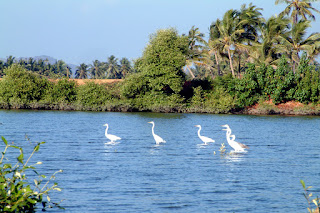By Gordon Lobo
It's twilight and the sun has just shied behind the thickets leaving a pleasant afterglow. A few children scamper home with fishing rods, some freshly cut from a bamboo cluster. The local catch was khorsandi, for which they used a small piece of prawn for bait.
Manu has just finished setting up his nets. He has three of these zaus all set in a row. This is Teen Manos, a picturesque place in a small corner of Aldona. A manos is a sluice gate, its holding pond is called poim in the local Konkani language.
Clambering down he sets his net, bracing each one with bamboo shafts on the sides and one in the middle, using his feet to check that the net is resting firmly at the base. He sets all the three nets and lets the tide do its work. The sluice gate is a system where the tide plays a major role in the poim as the water rushes out during the low tide through the gaping mouths of the net. There’s also a lot of floating twigs, leaves, plastic and other debris.
Sighting the moon overhead he knows he has a good two hours till the tide flushes the water out. He has to harvest his catch at least once before he pulls out the nets, as the water pressure bears heavily on them after they have trapped all the floating debris along with the catch. As an hour passes by he settles down to harvest his midway catch, before the full time is done.
The gollo is the funnel end of the net, with the finest net holes and is mostly of thick nylon so that the crabs have a tough time snapping and eating his catch.
He collects his catch in a tall woven basket and quickly pulls it up for sifting on a large plastic sheet. He and his mates empty some of the catch so as to sort out the debris, the sticks, leaves, plastic bags, litter, etc., from his catch. An old stool or an inverted paint bucket and old car tyres make do for seats as the sifting continues. A catch may comprise small prawns, a medium hard shell koddem, a fully grown big white prawn and an occasional tiger prawn. As they sort them out the lively catch keeps making a run for it by springing up and jumping out of his panttlo and bucket. He quickly grabs and chucks them back again.
After he's done with the catch he hauls the nets in and inverts them to clean out whatever small fry and twigs and leaves are stuck inside the net. By this time the ffn tide has slowly swelled and the sluice gates close with the returning high tide, making the poim ready for another type of fishing. This is the perfect time to cast the kanttiem, a large meshed fishing net with floats on the top while the rest of the net dangles freely in the water tangling all the passing prawns and fish, and an occasional crab too as it attempts to eat the tangled fish.
Late at night a bunch of hobbyists get together for a night out fishing, some with rods and others with line. The line is commonly known as poller. It has a hook about an inch long sometimes a little bigger, with a lead weight set after a span. The bait varies from a sardine to a small crab or a live fish or live prawn, all depending on what fish one is fishing for or what luck chances upon the angler.
A canoe (ponnel) is also used to fish in the night using a Petromax lantern to momentarily blind the fish with a bright light while slowly sneaking a small koblem net under the fish, whisking it stealthily into the canoe.
A common greeting ‘Oi!’ is bellowed in the night. Another set of fishers are fishing in the river. This is a branch of the Mandovi, where ore-laden barges ferry the land’s minerals to waiting offshore bulk carriers.
Back to fishing. These guys have placed a thick nylon line and hanging on this line at every meter is a big hook about two inches long. The line is weighed down at both ends with a heavy stone locally called davon, and is checked every 45 to 60 minutes. The bait is sometimes live, or sardines or squid. The catch can range from a red snapper to a stingray, or catfish or eel, and sometimes an old rag or sack.
And then there’s the Grope way. A koblem, a circular net from bamboo or the vine of a chunna tree, is used wherein the net is held in both hands and pressed to the bottom and then felt around for whatever is trapped inside. This method is called 'khampnem'. The ones without a koblem feel around the sides of the poim and around the rocks with their hands. This is called porshievunk or porshepak, literally meaning ‘to grope’. The catch is collected in a bamboo woven basket tied to the forehead, called konni.
The arrival of the rains also bring about a heavy flow in the open drains, the vaum, where the waters from the hills and higher terrain pour into the lower lying areas, finally flowing to the poim which leads to the river. During this continuous flow of fresh water, fish also travels upstream. Fishing in the night is most ideal at this time, usually using a bright light, a koblem or a sharp pointed metal rod. Good for crabs, catfish, pearlspot, carp (pitthov), and occasionally turtles.
............................
.
.
.
(Photo courtesy Pantaleao Fernandes)
(Photo courtesy Pantaleao Fernandes)



No comments:
Post a Comment